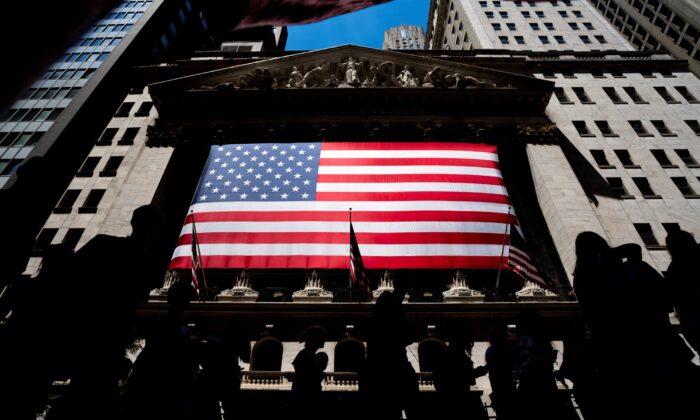A late-afternoon turnaround on Wall Street left stocks higher Friday as the market shook off a weak start amid worries about banks on both sides of the Atlantic.
The S&P 500 rose 0.6 percent after slipping for most of the morning. The benchmark index marked its second straight weekly gain. The Dow Jones Industrial Average rose 0.4 percent, while the Nasdaq composite ended 0.3 percent higher.
The upbeat close to the week came as markets have been turbulent on worries that banks are weakening under the pressure of much higher interest rates. That’s led to rising concerns about a possible recession and heavy uncertainty about what the Federal Reserve and other central banks will do with interest rates going forward.
“There are concerns out there about, obviously, a more severe bank crisis, both domestically and in Europe, and yet somehow markets are looking past that,” said Randy Frederick, managing director of trading & derivatives at Charles Schwab.
On Friday, much of the focus was on Deutsche Bank, whose stock tumbled 8.5 percent in Germany. Earlier this month, shares of and faith in Swiss bank Credit Suisse fell so much that regulators brokered a takeover of it by rival UBS.
Credit Suisse faced a relatively unique set of longstanding troubles. But the second- and third-largest U.S. bank failures in history earlier this month have cast a harsher spotlight across the entire banking industry.
Other big European banks also fell Friday, including a 5.5 percent drop for Germany’s Commerzbank, a 5.3 percent fall for France’s BNP Paribas and a 3.5 percent loss for UBS.
Bank stocks ended mixed on Wall Street. JPMorgan Chase fell 1.5 percent, while Bank of America rose 0.6 percent.
In the United States, the hunt by investors has primarily been for banks that could face a debilitating exodus of customers, similar to what helped cause the failures of Silicon Valley Bank and Signature Bank.
Investors have zeroed in on smaller and midsized banks, the ones below in size of the “too-big-to-fail” banks and seen as greater risks.
First Republic Bank closed 1.4 percent lower. It’s down 90 percent for the year.
Treasury Secretary Janet Yellen has said that in cases where the government sees a risk to the overall system, it will guarantee deposits for bank customers, even those with more than the $250,000 insured by the Federal Deposit Insurance Corp. That’s what regulators did for both Silicon Valley Bank and Signature Bank.
But Yellen this week also stopped short of a blanket guarantee for all depositors at all banks.
Cash-short banks were still lining up this week to borrow money from the Fed. The Fed said Thursday that emergency lending to banks fell slightly in the past week—to $164 billion—but remained high.
A big worry is that all the pressure on banks will cause a pullback in lending to small and midsized businesses across the country. That in turn could lead to less hiring, a weaker economy and a higher potential for a recession that many economists already saw as likely.
While the job market has remained remarkably solid, other parts of the economy have already begun to weaken under the weight of higher rates. On Friday, reports on the economy came in mixed. One showed orders for long-lasting manufactured goods were slower last month than economists expected.
A second report, though, suggested the fastest uptick in business activity for almost a year. The preliminary report from S&P Global topped economists’ expectations.
Federal Reserve Chair Jerome Powell said worries about a pullback in lending helped push the Fed to raise rates by only a quarter of a percentage point this week, instead of a more aggressive half point, in its campaign to battle inflation.
Higher rates can undercut inflation by slowing the entire economy, but they raise the risk of a recession. They also hurt prices for stocks and other investments. For Silicon Valley Bank and other banks, that meant hits to the super-safe Treasury bonds they owned.
The Fed has raised its key overnight interest rate to a range of 4.75 percent to 5 percent, up from virtually zero at the start of last year. It’s hinted it may raise rates one more time before holding them there through the end of the year.
Traders are more skeptical, though. The rising possibility of a recession has them betting heavily that the Fed will have to cut interest rates as soon as this summer to release some of the pressure on banks and the economy.
“Whether or not that happens, I don’t know, and obviously these things change a lot, but I would say there’s a very reasonable probability to say that rates right now may be as high as they’re going to go and we may just go sideways for a while,” Frederick said.
Such speculation has added to an increased drive by investors to pile into anything seen as safe, which together have caused huge, sometimes violent swings in the bond market.
On Friday, yields fell further. The 10-year yield, which helps set rates for mortgages and other loans, fell to 3.38 percent from 3.42 percent late Thursday. It was above 4 percent earlier this month.
The drop has been even more dramatic for the two-year Treasury yield, which more closely tracks expectations for the Fed. It sank to 3.77 percent from 3.83 percent late Thursday and from more than 5 percent earlier this month.
All told, the S&P 500 rose 22.27 points to 3,970.99. The Dow added 132.28 points to 32,237.53. The Nasdaq gained 36.56 points to close at 11,823.96.
Small company stocks outgained the broader market. The Russell 2000 index rose 14.63 points, or 0.9 percent, to 1,734.92.





